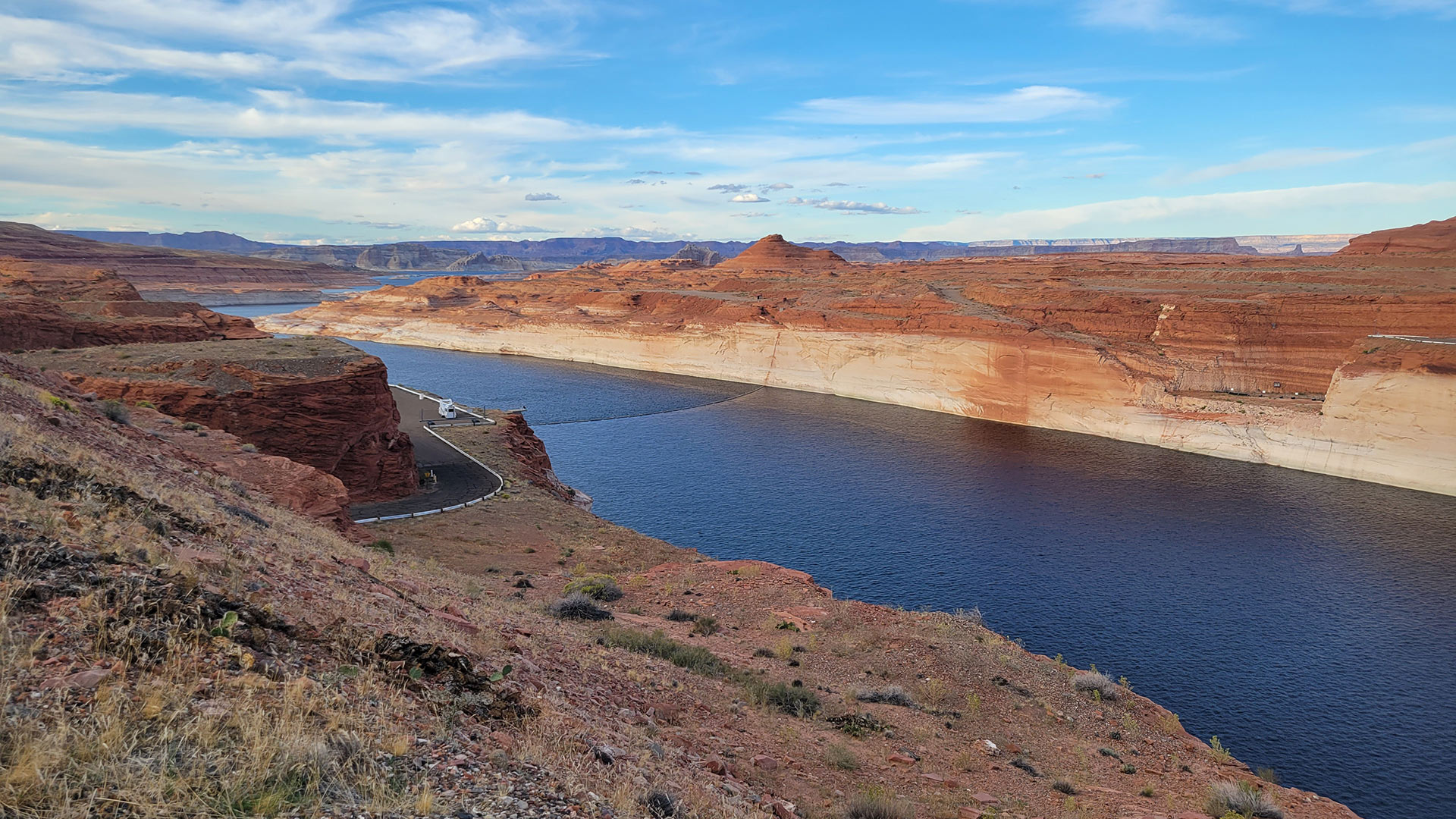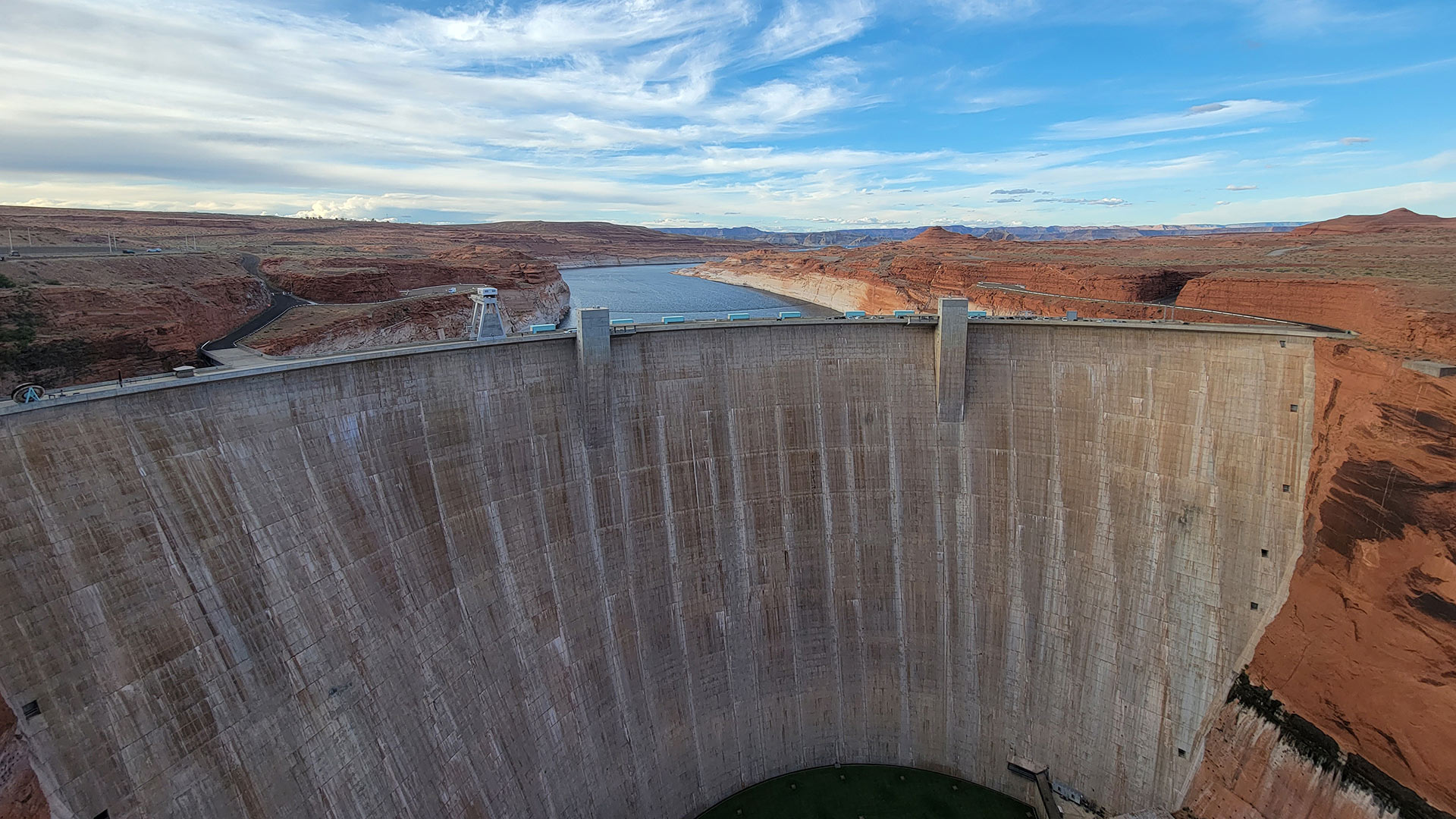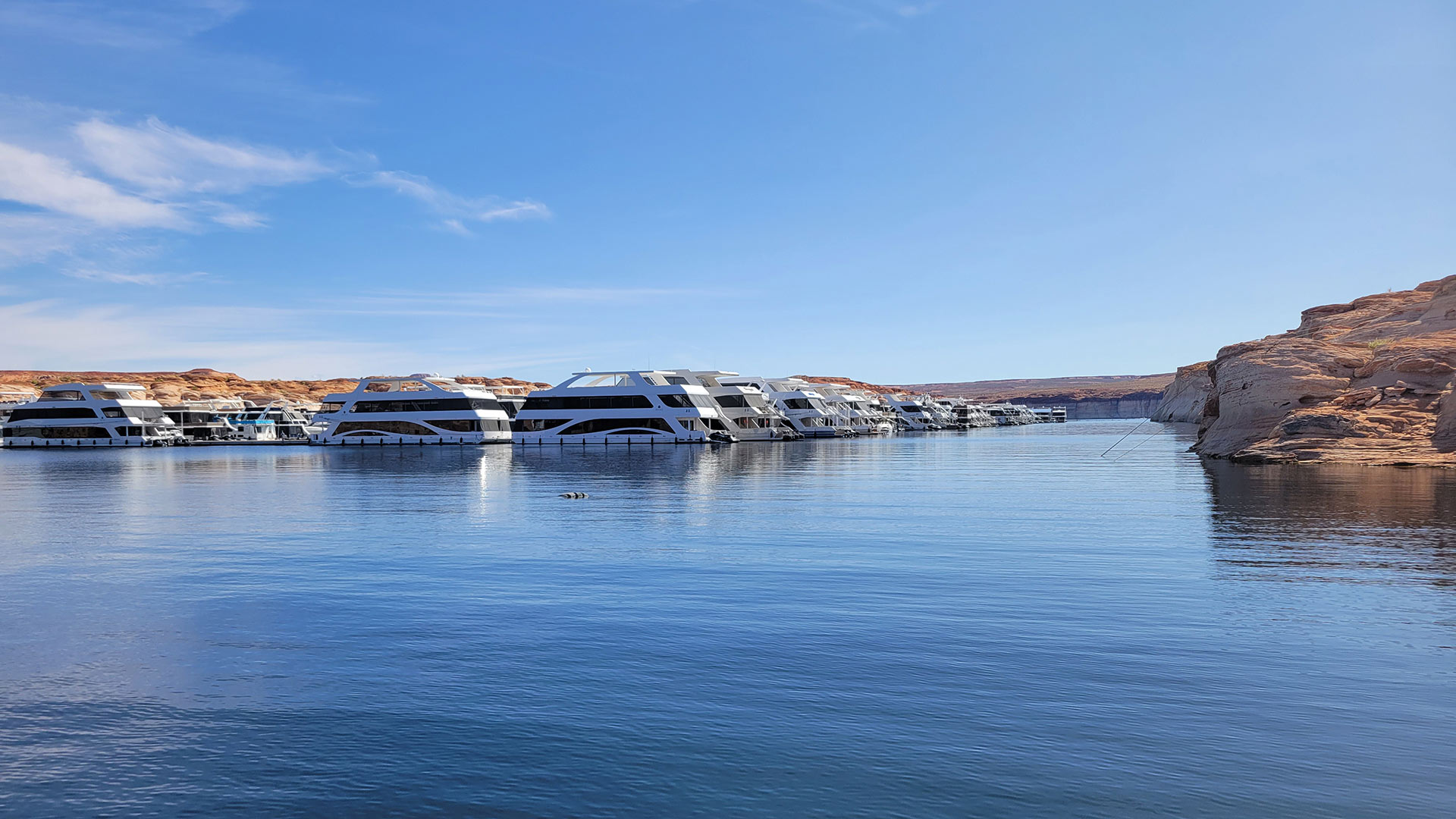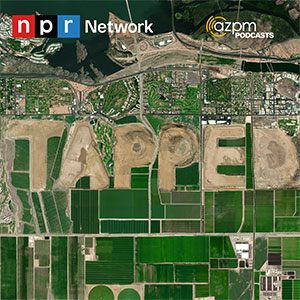 Bands of discolored rock show that Lake Powell's water levels are lower than they have been for much of its past.
Bands of discolored rock show that Lake Powell's water levels are lower than they have been for much of its past.
Season 2 Episode 7: More than stored water

Lake Powell is the reason Page, Arizona exists. The city of 7,500 started as a work camp for those building Glen Canyon Dam. Today, the lake and dam provide the it with water and electricity, and lake-related business accounts for about three-quarters of its taxbase. So how does the ebb and flow of the lake's main source of water, the Colorado River, affect life in Page?
This episode of Tapped was supported by a grant from The Water Desk, an independent journalism initiative based at the University of Colorado Boulder's Center for Environmental Journalism.
Episode transcription
(field audio) Debbie Moses: I'm just kind of giving an overview, okay?
Zac Ziegler: Yeah, yeah.
(voiceover) ZZ : I'm walking around the John Wesley Powell Museum in Page, Arizona.
DM: So we have a variety of different exhibits.
ZZ: That's Debbie Moses, executive director of the Glen Canyon Conservancy, which runs the museum.
DM: and it does focus on John Wesley Powell but also other explorers. Even before John Wesley Powell went down the Colorado River.
ZZ: You can easily identify him in that.
DM: Yes.
ZZ: He's the fellow with with half a right arm.
DM: Right. And you can even buy a pin, a little pin with the arm in our gift shops.
ZZ: Powell lost much of his right arm in the Civil War. He went on to become the second director of the U-S Geological Survey. But in between, he was known for an 1869 trip that mapped large portions of the Colorado River as it passes through the Grand Canyon.
So, when a 700-foot hydroelectric dam went up in the stretch of the Colorado River that Powell explored, he seemed a natural pick for whom to name the resulting reservoir after.
That dam does more than create electricity though, according to Joanna Joseph, a docent at the museum.
 Glen Canyon Dam holds back the Colorado River near the Arizona/Utah state line to form Lake Powell.
Glen Canyon Dam holds back the Colorado River near the Arizona/Utah state line to form Lake Powell.
JJ: A lot of people who come here as visitors, they just assume that Lake Powell is there for them as a playground. Of course it's really there for water storage and flood management. But of course it is a huge recreation area.
(theme music starts)
ZZ: And that recreation site is why a spot where construction crews set up campers and contemporary homes in the 1950s and 60s became a city that still exists today, a city whose existence relies almost entirely on Glen Canyon Dam and Lake Powell.
This is Tapped, a podcast about water. I'm Zac Ziegler.
This week, America's two biggest reservoirs sit partly in Arizona, where they help abate the seasonal ebb and flow of the Colorado River.
But for the people who call the area home, those man-made lakes are more than just stored water, they're the lifeblood of a community.
(theme ends)
Darren Coldwell: Lake Powell actually is Page's identity. When you think of Page you think of Lake Powell.
ZZ: That's Page City Manager Darren Coldwell, when I sat down to speak with him, he also brought in the city's Director of Economic Development, Gregg Martinez, so you'll hear them together often.
GM: Page was originally created as a base camp for the establishment of the Glen Canyon Dam which created the Lake Powell reservoir. That's the inception of our history. So it means a lot to us as community members to be stewards of that lake and to watch it grow to watch it shrink, to watch it struggle to watch it succeed. There's just a lot of our community pride and identity that's wrapped into Lake Powell.
ZZ: If you're not familiar with Page, it's about as far north as you can get in Arizona. It's one of a group of communities that are within a handful of miles of the Utah state line.
It was incorporated in 1975, almost a decade after construction on Glen Canyon Dam was finished.
 Page as seen from near Horseshoe Bend.
Page as seen from near Horseshoe Bend.
Activities around Lake Powell account for more than three-quarters of the City of Page's taxbase, be that government jobs at the dam or the Glen Canyon National Recreation Area, people who build and work on boats or the tourism industry.
The city has 7,500 residents, but it has 2,500 hotel rooms, 500 short-term rental listings, and about 50 restaurants. That allows the city to accommodate millions of visitors each year.
GM: The foundation of our tourism is built off of Lake Powell. Boating has been an industry here since the 70s, maybe even as early as the 60s.
DC: Yeah, the yachts.
GM: Yeah, so I mean, there's a huge amount of wealth tied into Lake Powell. And that trickles down into our community with jobs: mechanics, shopping at our stores, using our gas, etc. So there's all kinds of ways that it affects it.
ZZ: If you're surprised to hear the word 'yachts' in reference to an Arizona lake, you're probably not aware of how big Lake Powell is.
It covers about 250 square miles and can be nearly 600 feet deep in places. It has about 1,900 miles of coastline thanks to the way it meanders through dozens of canyons.
When full, it holds up to 24 million acre-feet of water. That's enough to feed a Phoenix area for nearly a decade.
 One of the large boat docks at Antelope Point Marina.
One of the large boat docks at Antelope Point Marina.
And at that size, you can see why a number of boats would call it home. And many of those boats are parked just outside of Glen Canyon National Recreation Area, at a marina on the Navajo Nation.
Ken Runnels: Well, Antelope Point Marina is a marina on Lake Powell. We offer all services on the water. We have a rental fleet that has household small boats, PWCs.
ZZ: That's Ken Runnels, the marina's chief administrator, and P-W-C is short for personal watercraft, think kayaks, canoes, standup paddle boards.
We operate what's called a term program that is more or less boats that have multiple owners where a different family will get on that boat every week. The boat will leave on a specific day and then come back, say that turn day is on a Monday, the next Monday, the next family will leave for a week. So we operate 65 boats on that. On the private side of the dock we more 200 houseboats . . .
ZZ: There's also boat tours of some of the canyons, charter boats, a store, plus what Ken calls America's largest floating restaurant, seating about 150 people.
KR: We're a full full service Marina. And I would tell you on Lake Powell, we provide more services than the other, the other two marinas that are on the lake.
ZZ: The water level here fluctuates between 300 and 400 feet deep lately, so the docks have to be tied to the sidewall of the canyon, with large cables routinely being adjusted to keep it properly affixed amongst those big variations.
KR: Our fluctuations are, one, due to the amount of moisture that comes into the Colorado and Utah mountains. And then to how much water they let out of the dam to go down to Lake Mead and down to California and things like that . . . So, when everybody was doing the stories about how the droughts affected and how low the water is, that really did not affect the recreation that much.
Newscast audio: Well now to our ongoing series Running Dry. Lake Powell slowly drying up and the feds keep pouring more . . .
This morning, our series Earth 365 looks at natural wonders emerging from a submerged past, but doing so at an alarming pace because of climate change. And one place this is happening is Lake Powell along the Utah/Arizona . . .
To save or not to save Lake Powell. That is the question the Bureau of Reclamation is now . . .
Fox 10 is taking a deep dive into the water crisis here in Arizona. It affects all of us from our tap water, our crops, even electricity and the supply is running short. Steve Nielsen went to Lake Powell to investigate . . .
ZZ: What Ken is talking about there was the influx of national media coverage that hit when water levels recently dropped low enough at Glen Canyon Dam to concern officials, possibly hitting the dreaded dead pool level, meaning water would be too low to flow through the dam and into the river below.
However, there was a more concerning level that it would have reached first, minimum power elevation.
That's the level at which the dam quits having the pressure, known as hydraulic head, needed to move turbines and generate electricity.
At either level, Lake Powell would still have a depth that could accommodate any of the recreational activities that occur on it.
Now, Ken and basically everyone I talked to in Page said the issue is the understanding of those facts by either the media or the people who read, heard or watched those reports.
KR: I didn't even have to watch the TV, I didn't even have to listen to the radio. I could tell the day after they ran one of those stories about how the West was going dry. The Colorado River was drying up, global warming all of the above, because we would start to get cancellations on our rental fleet.
ZZ: In recent years, Lake Powell follows a seasonal trend. Each spring, levels go up as snow melts in the Rockies. Once the snowpack is gone, levels start to drop again.
Since 2019, that spring increase hasn't been enough to offset the decreases the rest of the year. By January of 2023, the lake was about 200 feet below full pool, and getting close to that minimum power pool elevation in April.
But that still left hundreds of feet of water in many places.
That fact often got missed, and it left Page residents like Maxwell Lapekas struggling when people would call his company, Lake Powell Paddleboards and Kayaks, asking if there was still water in the lake.
ML: They'd definitely hear a little sigh. But it was a lot more frustrating the past two years than this year. Luckily, it's the news this year is that it's been on the way up, which has been a really good sign. But that question was a tough one to answer. Time and time again.
For Max, the biggest issue wasn't a lack of water, but the constant changes: where he could most easily launch from, where his guides could take people . . .
ML: Antelope Canyon has always been accessible. That's the main bread and butter, Our rentals over in Wahweap Bay, it changes that because sometimes a ramp is open. Sometimes a ramp isn't open. So we have to move locations which has ripple effects into every part of our business. Whether that be who we hire, when we hire people. How we explain to the customer where they can go, where they can't go. The past four or three years, we've had to change our business model probably five times. So you really have to keep your head on a swivel and hire people that are open to change.
ZZ: And it's not just nature tours on P-W-Cs that come to that same issue.
Bill McBurny runs Ambassador Guides, a charter fishing boat company. He's made his living off this stretch of the Colorado River for 40 years, starting with river expeditions downstream of the dam.
He says reservations used to be made a ways out and as part of massive trips to see the west's canyon lands.
BM: Years past, when we would be booked, usually six months to a year in advance, people planning their vacations to come to Lake Powell. So we booked that far in advance so people can plan part of their itinerary for their vacation to see Lake Powell and probably the canyons up here. We're adjacent to Bryce to Zion. You've got to the Grand Canyon.
ZZ: After the recent drop, his job has also gotten notably harder as he struggles to get to his preferred fishing spots.
BM: Lake levels affect everybody here, all the businesses. Especially when the ramps are closed. And the Park Service had to put him in an auxiliary ramp this last year and thank goodness. But it really affects the cost of everybody's operation because when water is at a prime level, not necessarily full all the way, you've got a fairly straight shot up Lake Powell. Now, all the islands have become peninsulas at low water. And so it stretches the lake out and that stretches the cost of going to and from.
ZZ: He says this same thing happened when a similar drop happened in the 1990s.
BM: All the major media came in and just filmed the canyons that were drying up on the backside where the water comes in from the 90-some canyons on the back where the water is gonna drop and never filmed the lake. And so the negativity comes into all the businesses. One paper one, publication would say, 'they're drying up.' And yet we're sitting on the main channel, we're still sitting back then on 400 feet of water.
ZZ: But, as the water levels come back up, many people, such as Max at Lake Powell Paddleboard and Kayaks, says the business returns because the bad news has died down and the lake is still as beautiful as ever.
ML: Lake Powell is, it's one of a kind. There's nowhere else in the world that you can paddle on flat water through tall narrow canyons with red, red and white rock surrounding you. The weather here can be it can be absolutely perfect, flat water, no wind in the morning, it can get a little breezy in the afternoon. But the contrast and landscape, I think is, is something that's completely unique to this area. And that people come here from all over the world to see.
ZZ: But the future of this one-of-a-kind spot isn't necessarily guaranteed.
The Bureau of Reclamation's operating guidelines for the Colorado River and its reservoirs expires in 2026, and it is in the early stages of a new environmental impact statement, according to reporting by the Arizona Daily Star's Tony Davis.
And while that has brought about the usual chorus of environmentalists who oppose the existence of the dam, it's also making strange bedfellows of those who have long opposed the existence of Glen Canyon Dam and a man that the Palm Springs Desert Sun called a "farm baron" who stands out even among the landowning elite of California's Imperial Valley.
Mike and James Abatti sent a letter to the Bureau of Reclamation, advocating for the dam to be decommissioned due to the amount of water lost to evaporation.
So the Abattis join a chorus that includes groups like Save the Colorado, who have been lobbying to remove the dam for decades.
Gregg and Darren and the City of Page think they would find a way to make the loss of that major tourism draw work should it ever happened.
GM: We have taken every lemon and turned it into lemonade. We really looked at the international tourism being really stopped because of the pandemic as a way to reintroduce ourselves to the domestic travel. And we did a really nice job about that. We've really been strong in Arizona, Utah, California, Nevada, Texas, Florida, New York. These are all places that love to come and recreate in our area and you know, not that we believe that the dam is necessarily going away. But, we are a resilient group. And that is what makes rural America so special is how resilient we can be. So if something happens that we can't control, that lake, that dam goes away, you better believe that we're going to give ourselves a puncher's chance in a boxing match.
DC: I mean, we had even with the lake levels for two years being ridiculously low. I mean, it's still beautiful. I mean, going over that bridge, and looking at the canyon is amazing. That's what people do, they stop and look at that. We still had over 26 months in a row of growing tax revenues. So even through COVID, even through all that, even with the bad press with the lake, Page still managed to grow its tax revenue through all the different heartaches that we faced.
ZZ: But Ken at Antelope Point Marina wasn't so confident when I asked him
KR: Well, obviously, if they removed it, it would be devastating to Page. You would see Page basically become almost a ghost town. Our operation, you know, I don't know, it depends on how much the water level dropped. But when I hear people talk about that, I'm thinking that's not even realistic.
ZZ: He says that because it would be the end of the electricity that feeds four-and-a-half million homes around the west.
And Max at Lake Powell Paddleboards and Kayaks says the place that Glen Canyon Dam holds in his life is something that's always caused an internal battle within him.
ML: If the lake did drop and it reformed a river, it would probably be a beautiful river. But the thing I think about is the recovery time and how long it would take this place to look beautiful again after that lake is dry. Because I know for a fact that there is hundreds and hundreds of sunken boats, there's trash, there's cables, tires, cement blocks, like the bottom of that lake would look so gross for so long.
That's something that I kind of battle with. I went to school for environmental studies and sustainability. And I'm, I like to think of myself as a little bit of an environmentalist. So I see both sides of it. I think the dam and the lake, in its terms of water storage, helped us build the southwest. But I also don't necessarily believe that dams are a good thing for the ecosystem. So it's a little bit of an internal battle.
 Page as seen from near Horseshoe Bend.
Page as seen from near Horseshoe Bend.
(theme music fades in)
ZZ: Page is kept alive through the Colorado River. It provides its main tax base, its electricity and its water.
When the lake levels dropped, the city actually had to build new infrastructure to ensure that last one kept going.
And it's not the only place where the water of the Colorado River feels so close, yet the people who live there struggle to get what they need of it.
In fact, if we head just a little bit downstream, past the dam, past Horseshoe Bend and into the biggest tourism draw in Arizona, you'll find another spot where aging infrastructure leaves people struggling to get their water.
That's next time.
Tapped is a production of AZPM News.
This episode was mixed and produced by me, Zac Ziegler.
It was edited by AZPM's News Director, Christopher Conover.
Our theme music is by Michael Greenwald.
Visit our website in the podcast section of azpm.org for pictures, links and more. Thanks for listening.
(music fades out)
This episode of Tapped was supported by a grant from The Water Desk, an independent journalism initiative based at the University of Colorado Boulder's Center for Environmental Journalism.


By submitting your comments, you hereby give AZPM the right to post your comments and potentially use them in any other form of media operated by this institution.